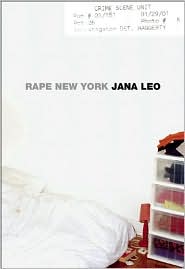
Publisher: The Feminist Press at The City University Of New York(CUNY)
Release Date: February 2011
Rape New York by Jana Leo is an exploration of the harsh realities of life in New York City. The book opens with the author returning home, only to discover she has been followed to her apartment door by a gunman. She gives all of the vivid details of the home invasion – her begging the armed man if she could keep a dollar to asking him to wear a condom. Jana Leo spends some time introducing us to her life, explaining why she lived in Harlem and how she hoped that her and her white boyfriend would fit in because they were impoverished. She didn't want to be viewed as someone who was determined to push out the resident population. She devotes a section of the book to a method of gentrification: how violence is Harlem is being used to devalue the buildings which are then bought and demolished to make room for condominiums. She also discusses how apartment buildings are left unsecured, allowing criminals to travel rooftops undetected. Understandably, rape altered the life of Jana Leo. It became the focus of her studies and her life. Rape is not an uncommon event that happens in a foreign location – it often happens in or around the victim's home.
For a female reader, Leo's book is frustrating. She acknowledges that strict fire safety codes are in place for buildings, but no enforced codes to protect tenants from criminal activities. There are basic regulations pertaining to secured lobbies, windows, and gates; however, such regulations are poorly enforced. The book spends a great deal of time expressing the disinterest the police showed in Leo's rape. They did not place surveillance around her former apartment, they were uninterested in where the rapist lived, and they didn't care that the rapist intended to kill her if she reported his crime. Although odds were not in her favor, Leo did not give up on finding justice. With Rape New York, we are with Leo from beginning to end. We see her as a victim and as someone fighting for her value as a human being.
Leo's book truly dissects New York City and shatters the Hollywood image it carries. It reveals a New York where slumlords reign while residents work minimum wage jobs and fear for their safety. Her book addresses every fear a woman could possibly imagine. Every female reader will have an easy time relating to the concerns addressed by Jana Leo. Rape New York is a well composed book that reads quickly – it will leave you on the edge of your seat until the very end. If Leo intended to leave a bitter taste in the mouths of readers, she certainly has succeeded. The reality of life in New York is horrifying.


